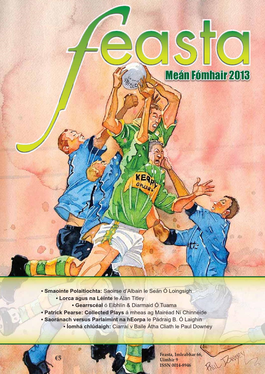Feasta is an Irish-language magazine that was established in 1948. Its purpose is the furtherance of the aims of Conradh na Gaeilge (Gaelic League), an objective reflecting the cultural nationalism of the language movement, and the promotion of new writing. Feasta describes itself as a review of Irish thought, literature, politics, and science (Reiviú den Smaointeachas Éireannach - litríocht, polaitíocht, eolaíocht).[1] It was formerly supported by Foras na Gaeilge, but this support was withdrawn because of a review of funding priorities.[2] At present the magazine relies on its own resources.[3]
 | |
| Editor | Cormac Ó hAodha |
|---|---|
| Former editors | Pádraig Mac Fhearghusa |
| Categories | Irish literature |
| Frequency | Monthly |
| First issue | 1948 |
| Country | Ireland |
| Based in | Cúil Aodha |
| Language | Irish language |
| Website | feasta.ie |
History
editFeasta's foundation in the 1940s reflected the progress made in Irish-language journalism and writing generally since the Gaelic Revival. Together with other journals such as An tUltach and Comhar, it was an agent in adapting the language to the requirements of the modern world, and helped determine the course of Irish-language writing.[4]
The magazine has had many editors, the longest serving being the poet and educationalist Pádraig Mac Fhearghusa. Previous editors also included Seosamh Ó Duibhginn (later Irish-language editor of The Irish Press), Eoghan Ó Tuairisc, Séamas Ruiséal, Aogán Ó Muircheartaigh and Íte Ní Chionnaith, who was also the first woman elected as president of Conradh na Gaeilge. The current editor is Cormac Ó hAodha.[5]
Despite its links with Conradh na Gaeilge, Feasta functions as an independent magazine and notes that the views expressed therein are not necessarily those of the Conradh itself.
Scope
editFeasta publishes literary criticism, reviews, and social and political commentary, with some regular columnists. Social and cultural events relating to the Irish language are also covered. Poetry is published regularly and past contributors have included Máirtín Ó Direáin, Máire Mhac an tSaoi, Seán Ó Ríordáin, and Nuala Ní Dhomhnaill.[6] The magazine also publishes short fiction, with particular emphasis on new writing. Despite its general emphasis on the linguistic and cultural situation in Ireland, Feasta publishes Irish-language material from overseas when available.[7] The magazine also carries advertising by Irish-language publishers.
See also
editReferences
edit- ^ www.feasta.ie http://www.feasta.ie/. Retrieved 13 January 2011.
{{cite web}}: Missing or empty|title=(help)[title missing] - ^ Ferdie Mac an Fhailigh (former Chief Executive of Foras na Gaeilge): ‘Promotion of Irish online and through publications must be strategic,’ Irish Times, 2 May 2014: http://www.irishtimes.com/culture/promotion-of-irish-online-and-through-publications-must-be-strategic-1.1780572
- ^ 'Litir do Chairde Feasta,' Feasta, Meitheamh 2014, p. 27.
- ^ Mac Congáil, Nollaig (2003). Feasta, Innéacs 1948 - 2000. Feasta. p. 8.
Chuidigh na foilseacháin sin ach go háirithe leis an Ghaeilge a thabhairt isteach sa nuaré agus dúshraith bhuan a leagan dár tharla i gcinniúint fhoilsitheoireacht agus scríbhneoireacht na Gaeilge ó shin.
- ^ Nuacht RTÉ,12 December 2019: "Cormac Ó hAodha ina eagarthóir nua ar Feasta": https://www.rte.ie/news/nuacht/2019/1209/1097958-cormac-o-haodha-ina-eagarthoir-nua-ar-feasta/
- ^ Mac Congáil, Nollaig (2003). Feasta, Innéacs 1948 - 2000. Feasta. p. 10.
- ^ Such material usually consists of short fiction and poetry: see, for example, Feasta, Imleabhar 63, Uimhir 2, Feabhra 2010, and Imleabhar 63, Uimhir 4, Aibreán 2010.
Further reading
edit- Caerwyn Williams, J.E. and Ní Mhuiríosa, Máirín (1979), Traidisiún Liteartha na nGael. An Clóchomhar Tta, Baile Átha Cliath.